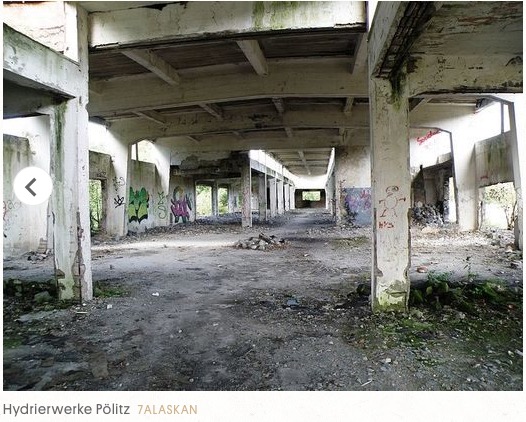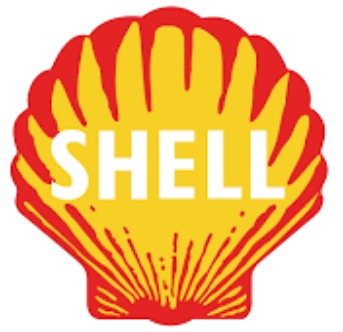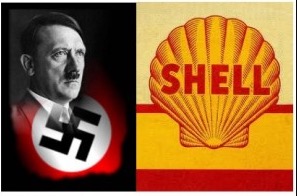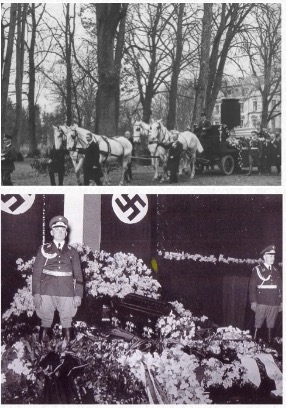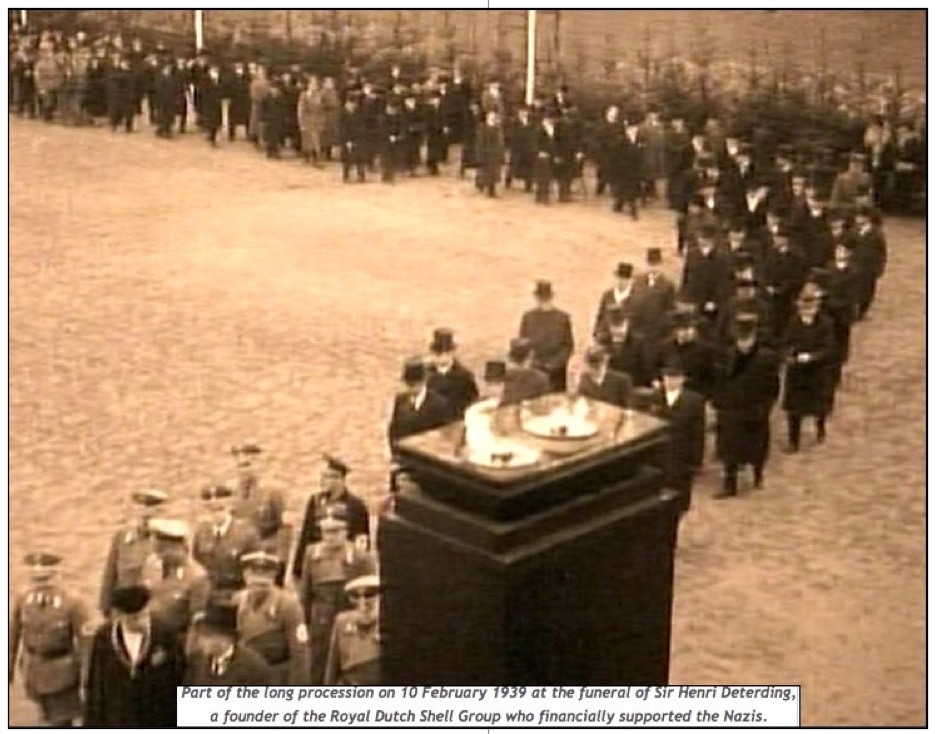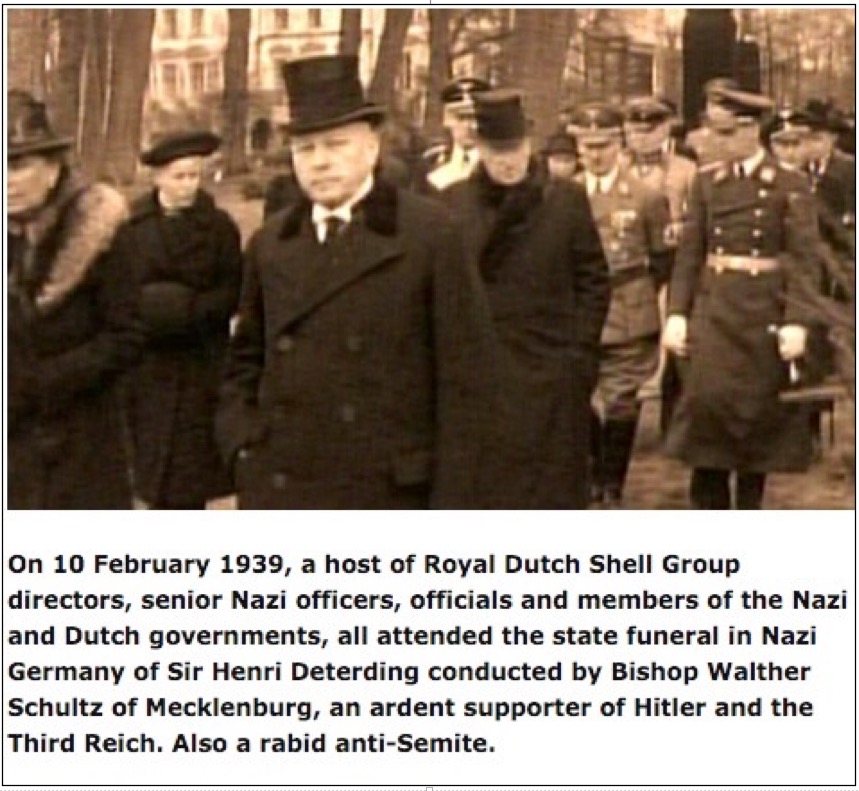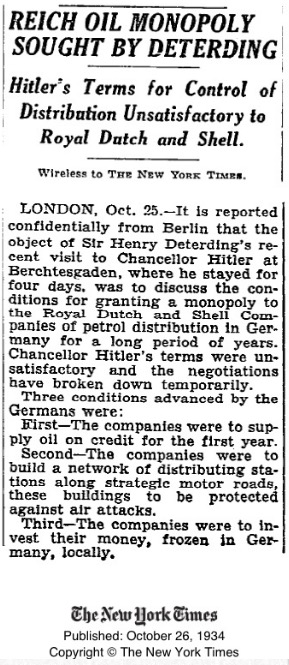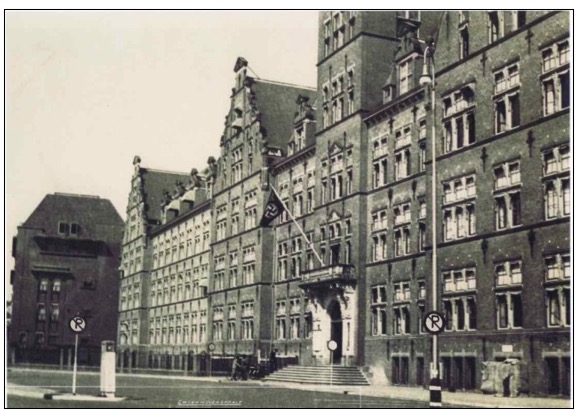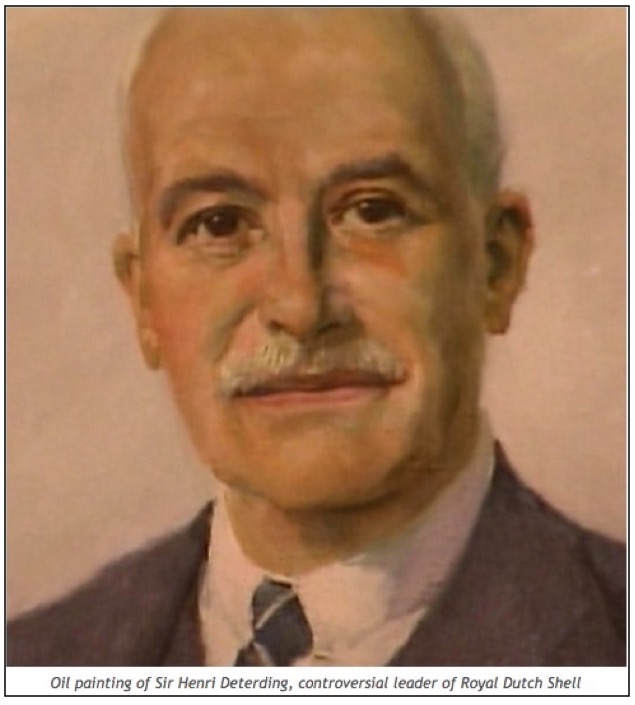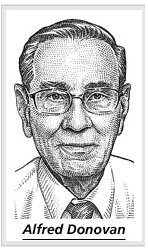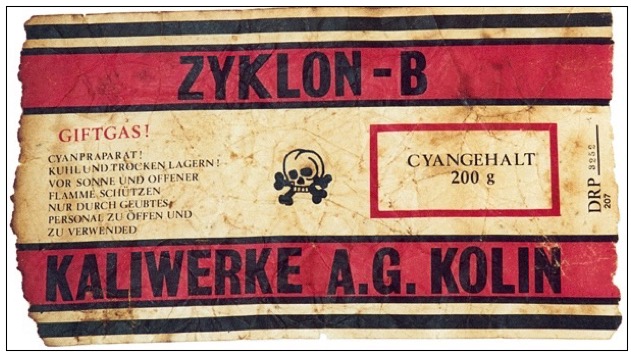
Several IG Farben directors were found guilty of war crimes arising from their actions during WW2. The firm manufactured large quantities of Zyklon-B gas used by the Nazis to kill millions of Jews at extermination camps during the Holocaust. Royal Dutch Shell was a business partner of I.G. Farben both in Germany and globally.
Prior to WW2, Royal Dutch Shell had been a business partner both internationally and in Germany, with I.G. Farben (Interessen-Gemeinschaft Farbenindustrie AG.
IG Farben was formed in 1925 from a number of chemical companies and became the largest chemical company in the world. Involved in war crimes during WW2, the company was seized by the Allies in 1945 and liquidated in 1952.
Part of the above information is from a Wikipedia article about IG Farben.
Some related extracts from Holocaust Education & Archive Research Team:
First extract – confirming that Royal Dutch Shell German subsidiary Rhenania-Ossag founded a synthetic fuel plant in which IG Farben was a partner.
In 1937, IG Farben, Rhenania-Ossag, and Deutsch-Amerikanische Petroleum Gesellschaft founded the Hydrierwerke Pölitz AG synthetic fuel plant. By 1943, the plant produced 15% of Nazi Germany’s synthetic fuels, 577,000.
Second extract – confirming IG Farben was itself a financial supporter of the Nazi party.
At a meeting of leading German industrialists with Hjalmar Schacht, Hermann Goering and Heinrich Himmler, held on the 20 February 1933, IGF contributed 400,000 reichsmarks to the Nazi Party…
Information from pages, as indicated below, from TRIALS OF WAR CRIMINALS BEFORE THE NUERNBERG MILITARY TRIBUNALS VOLUME VII: (1,616-pages so may take a while to load):

a) Extract from Count Three of a war crimes indictment against I.G. Farben concerning enslavement in the same TRIALS OF WAR CRIMINALS document:
From Page 189 of 1,616 pages
The evidence under this count relates primarily to the use and abuse of prisoners of war, the enslavement and deportation to slave labor and mistreatment of many thousands of civilians in the countries occupied by Germany, the conducting of atrocious medical experiments upon enslaved persons without their consent, and the extermination of slave workers who had been used up and were no longer of value as laborers.
b) Extract from pages 1080/81 of 1,616 pages – a translated extract from the Weekly Reports of the Military, Economy and Armaments Office of the German High Command concerning Farben and Mobilization Plans.
16 September 1938
Conference at the Reich Ministry of Economics concerning the control of the production of mineral oil in case of mobilization. Together with the Reich Ministry of Economics, which has already drawn up an organization for the distribution of mineral oil, an organization for control of mineral oil production has been set up with the cooperation of the industry. The Control Office (in case of mobilization the Reich Office) will have subordinated to it three large groups of producers, namely:
1. Production of benzene and corresponding products. For this, a compulsory syndicate under the direction of the Benzol-Verband (Direktor Hansen) is planned.
2. The production of mineral oil on the basis of lignite and coal (excluding benzene). Under direction of Dr. Buetefisch, I.G. Farbenindustrie.
3. The production of mineral oil on the basis of petroleum, under the direction of Generaldirektor Brochhaus, Deurag. Assisting him are Direktor Dr. Boeder, Rhenania-Ossag, and Dr. Brunck, Deutsche Gasolin.

As previously mentioned, Rhenania-Ossag was a Royal Dutch Shell subsidiary and Shell was a partner in Deutsche Gasolin.
In 1939, Dr. Erich Boeder, was Director General of Rhenania-Ossag oil works and represented the company in dealings with the German 21 Army Group in relation to the production of mineral oil for petroleum. In 1954, Dr Boeder was vice-chairman of the board of Deutsche Shell AG. Search the linked web page for “Boeder.”
c) Information sourced from pages 1202 to 1206 (within the 1,616-pages):
Testimony from an IG Farben defendant August von Knieriem during cross-examination confirmed that Royal Dutch Shell, led by Sir Henri Deterding, partnered with IG Farben and Standard Oil in purchasing oil from the US government. The deal involved transporting to Germany some 20 million dollars worth of oil for the Nazi government. IG Farben did not disclose to the US government that the oil was for the Third Reich. Although August von Knieriem was evasive, he did admit the transaction involving Shell, was “irregular.“
Information along the same lines is confirmed on pages 1310/1311.
The purchase arrangement was also confirmed in an article published in The New York Times on 19 October 1945:
“Standard Oil and the Anglo-Netherland Royal Dutch Shell group also aided I. G. Farben in 1934 and 1935 to purchase large quantities of mineral-oil products, the report said. These products, including airplane benzine and lubricants, were bought for a market price of $20,000,000 and stored as reserve stocks.”
In September 1938, according to the 1,616-page record of the military tribunal, senior managers of companies partly and wholly owned by Royal Dutch Shell were involved in German High Command military contingency planning. An accurate summation of the facts based on the quoted information within the tribunal record.
The military planning took place while Shell was in full control of Rhenania-Ossag. The Nazis did not appoint a Verwalter for Rhenania-Ossag until January 1940. Oil supply was obviously a vital element in the coming war.

An extract from a YouTube feature confirms that IG Farben supplied Zyklon-B gas to the Nazi death camps:
Most notoriously, the firm’s pro-Nazi leadership openly and knowingly collaborated with the Nazi government to produce the large quantities of Zyklon B necessary to gas to death millions of Jews and other “undesirables” at various extermination camps during the Holocaust.
According to testimony in the Nuremberg War Crimes Trials, IG Farben was the sole producer of poison gas in World War 1. The company played the leading role in fueling the Nazi war machine:
“Germany could not have waged war without Farben’s help.”
“The German war machine was not merely dependent upon Farben for obtaining the critical raw materials essential to modern warfare. It could not have functioned without the products manufactured for it by Farben.”
IG Farben engaged in horrific activities.
Extract
REPORT ON THE INVESTIGATION OF I.G. FARBENINDUSTRIE A.G. prepared by a US Military Government division:
“This investigation has disclosed that an I.G. Farben official at Wuppertal-Elberfeld developed the deadliest poison gas in the world. This gas, unknown to the military authorities of the Allied Nations, could have penetrated any gas mask in existence. I.G. originally carried out its poison gas experiments on monkeys; later on human beings. For the latter purpose, inmates of concentration camps were selected, and I.G. Farben officials, concerned only with creating weapons capable of assuring German world conquest, were unmoved by this use of human guinea pigs.”
To achieve Nazis government objectives, I.G. Farben used forced labor on an extensive scale.
Extract from the OFFICIAL RECORD/TRANSCRIPTS United States Military Tribunals Nurnberg of the IG Farben Trial at Nuremberg: 27 August 1947, Court 1, Case 6.

Extract from page 6
A. Farben and the Slave Labor Program.
The slave labor program of the Third Reich was the revolting offspring of the aggressive wars which it planned and waged. It was designed to keep the German war machine rolling at the frightful expense of the freedom and lives of millions of persons. The tyranny and brutality of Nazi conquest was felt by them not only in their own homelands of France, Belgium, Holland, Russia, Poland, Czechoslovakia, Denmark, and elsewhere. Hundreds of thousands suffered the additional misery of being torn loose from homes and families and shipped to Germany into slavery and more than often to a miserable and premature death.
Extract from page 166 of the same document:
The defendants, through the instrumentality of Farben and otherwise, not only knowingly participated in the employment of foreign slave labor, but were aggressive in its procurement.
Extracts from page 167 of the same document:
Farben’s motto was “production at any cost”. Farben representatives were sent to all occupied countries to procure workers.
Extract from Yale Law School document: Nuremberg Trial Proceedings Volume 3:
Nuremberg prosecutor Thomas J. Dodd declared:
It may illuminate the specific items of evidence which will be offered later if we first describe in rather general terms the elements of the Nazi foreign labor policy. It was a policy of mass deportation and mass enslavement, as I said a minute ago, and it was also carried out by force, by fraud, by terror, by arson, by means unrestrained by the laws of war and laws of humanity, or the considerations of mercy. This labor policy was a policy as well of underfeeding and overworking foreign laborers, of subjecting them to every form of degradation, brutality, and inhumanity. It was a policy which competed foreign workers and prisoners of war to manufacture armaments and to engage in other operations of war directed against their own countries. It was a policy, as we propose to establish, which constituted a flagrant violation of the laws of war and of the laws of humanity.
Extracts from Time Magazine article published 24 December 1945 under the headline “Cartels: Gulliver, Bound but Sturdy”:
“Without I.G… Germany could not have waged the war at all.” “As armorer for the Nazis, I.G. made all of Germany’s synthetic rubber and lubricating oil; 95% of its poison gases (Farben tested them on concentration camp inmates); 90% of the nickel; 88% of the magnesium, most of the gasoline and explosives for the buzz-bombs and V-2s.”

Extract from a newspaper article published in The Times on 6 May 1947 under the headline: “War Record of I.G. Farben”:
Extract
The indictment precisely describes Farben’s major contribution to German rearmament as the synthetic production of nitrates, oil, and rubber, without which Germany, having no natural resources, was incapable of preparing or waging aggressive war. Farben was the core of military mobilization not only by virtue of its own production but because all other German chemical companies and many other war industries were almost totally dependent upon its products. German tanks, artillery, and armoured vehicles rolled on Farben electron metal wheels, were shod with Farben buna rubber, and propelled by Farben synthetic petrol. Nazi bombers were armoured with Farben aluminum and magnesium alloys, carried death loads of Farben incendiary bombs and explosives, and were fuelled by Farben high-octane aviation petrol.
IG Farben shared patent rights to synthetic oil (and other products) with many companies. They included Royal Dutch Shell and Standard Oil, both of whom had other business connections with Farben.
Further evidence:
Extract from Daily Telegraph article “Slave labourers given flowers and £3,000 each”:
The ceremony was held at Goethe University, Frankfurt, in a sprawling building that was the wartime headquarters of the German chemical firm IG Farben, supplier of Zyklon-B gas to the Nazi death camps.
Extract from page 345 of “The Prize” – a book by Daniel Yergin:
Auschwitz was the largest of the Nazi mass murder factories; upwards of two million people, mostly Jews, were put to death there with gas manufactured by an 1. G. Farben subsidiary. The stench of the crematoriums at Auschwitz and Birkenau suffused the air at Monowitz. To Levi, it was “world of death and phantoms. The last trace of civilization had vanished.”

Extract from Time Magazine article 12 May 1947:
Most damning charge was that Farben experimented on slave labor and concentration camp inmates with “deadly gases, vaccines and related products.” To supply slave labor for its synthetic rubber plant at Oswiecim, Farben allegedly constructed a concentration camp and worked the men, women & children so hard that an estimated 100 a day died from exhaustion. The U.S. would have no trouble proving that the Nazis could not have made war without Farben.
IG Farben directors were later convicted of war crimes in the Nuremberg trials for enslavement and for the mass murder of civilians, prisoners of war and concentration camp inmates.
IG Farben manufactured explosives and other vital war materials, including oil and gasoline, which fuelled Nazi tanks and planes used in the blitzkrieg.
Extract from page 46 of “George Bush: The Unauthorized Biography”:
Farish was the principal manager of a worldwide cartel between Standard Oil Co. of New Jersey and the I.G. Farben concern. The merged enterprise had opened the Auschwitz slave labor camp on June 14, 1940, to produce artificial rubber and gasoline from coal. The Hitler government supplied political opponents and Jews as the slaves, who were worked to near death and then murdered.
Extracts from an article published by The Times on 20 October 1965:
EXTRACTS
The willfully planned and demoniacally organized extermination of five million human lives in the infamous wartime concentration camp in Auschwitz was so monstrous an undertaking that the ordinary human mind is quite incapable of grasping its enormity.
Secondly, there is the perfectly well-established point that the able-bodied were sent to Auschwitz to be financially exploited as slave-labour for large German industrial concerns (they are named in the trial report and in the play, so let us not be squeamish about naming them here), concerns like I.G. Farben…
Shell and Standard Oil were partners with IG Farben in Deutsche Gasolin A.G., which operated a refinery and gasoline service station network in Germany, under the Leuna brand name.
There is a full-page photograph between pages 108 & 109 of DOING BUSINESS WITH THE NAZIS By Neil Forbes: First published in 2000 in Great Britain by Frank Cass publishers. ISBN 0-7146-8168-7. It shows a series of what appears to be storage tanks on a train standing at a refinery plant, with a worker standing on top of the nearest one, filling it with fuel.
The photo caption states:
17. Wagons being filled with Leuna-Benzin, the synthetic oil produced by IG Farbenindustrie in partnership with Standard Oil and Shell.
(Photo: AKG London)

Related extract starting on page 153
Standard Oil entered into a contract with IG (the exclusive purchasing agent in Germany for a number of vital products including oil and rubber) to sell the rising outputs of the Leuna plant. Shell reached a similar agreement in 1935. As a reinsurance against future competition from synthetic fuel, both these majors took a 25 per cent share holding in IG’s Deutsche Gasolin AG. In strictly commercial terms this decision made sense. By 1939 IG’s synthetics factories produced no less than one-half of the petroleum consumed in the Third Reich.
A related letter to The New York Times: Letters: The Synthetic-Gas Story: 8 Sept 1973
EXTRACT
From 1933 to 1938 I worked as economist for the Deutsche Gasolin A.G. in Berlin. We sold the Leuna gasoline the Aug. 26 letter: Gasoline from Coal” referred to through a network of service stations that covered Germany. Whatever amount we could not dispose of was taken over by Shell and Standard Oil, who owned 24.5 per cent each of the shares of the company; I. G. Farben owned the rest. Leuna gasoline was the product of a hydrogenation process.
During WW2, the IG Farben Leuna works covered three square miles of land with 250 buildings, including decoy buildings outside the main plant. The company employed 35,000 workers, including 10,000 prisoners and slave laborers.

As is evident from the 1,616-page Nuremberg court document, Hitler attached great importance for obvious reasons, to having an independent supply of fuel. He took a personal interest and long before WW2 met personally with Heinrich Buetefisch, Farben’s manager of Leuna Plants and gasoline production. See page 536 of the court document.
Buetefisch was later given the rank of Lieutenant Colonel in the SS and eventually ended up with a six-year jail sentence for War Crimes.

A book authored by Natalie Silverman, published in 2012 under the title: “THE STORY BEHIND THE HOLOCAUST: Forgive and Forget” contains some relevant information to which I attach a health warning.
Extract from page 201:
Benzinwerke Rhenania (Shell) and I.G. Farben Industrie were co-founders of Deutsche Gasoline (the National German Petroleum Company) to give the Nazis control over fuel production. The Nazi government had a 25% interest in Deutsche Gasoline. The chemical synthesis division of Deutsche Gasoline produced Zyklon B poison gas. After the war the company name changed to Deutsche-Shell.

The following are extracts from an article by Atlas Obscura (pdf version downloaded on 21 March 2020) about the Pölitz synthetic fuel plant jointly owned by IG Farben, Shell Group subsidiary Rhenania-Ossag and Standard Oil.
The article is published under the headline: Hydrierwerke Pölitz
This now-defunct synthetic fuel plant was once a major cog in the Nazi war machine.
Constructed in 1937 in what was still considered Germany, this synthetic fuel manufacturing plant used high pressured hydrogenation processes to convert powdered lignite coal into liquid fuels. This included a good deal of high-grade gasoline. The process was called the Bergius process, named after its inventor and Nobel prizewinner, Freidrich Bergius. The plant was jointly owned by IG Farben, Rhenania-Ossag, and a German subsidiary of Standard Oil.
Throughout World War II, the plant also acted as a subcamp for the Stutthof, Sachsenhausen and Ravensbrück concentration camps, whose prisoners made up a majority of the plant’s labor force. About 30,000 laborers were forced to work at the plant from 1939 to 1945. Around 13,000 died.
The scale of the site is impressive. At its peak, the plant was producing a large amount of Germany’s liquid fuels. Without this plant, Germany’s initial success during WWII, particularly their invasion of Russia, would have been impossible.
What is beyond doubt is that Royal Dutch Shell was in bed in multiple business ventures for many years with the evilest company in history, IG Farben, an indispensable part of the Nazi war machine.
The next chapter deals with the slave labor aspect.
ENDS
Copyright Notice: All rights, including copyright and compilation in the content of shellnazihistory.com web pages authored by John Donovan are owned or controlled for these purposes by him. In accessing the said web pages, you agree that you may only download the content for your own personal non-commercial use. Except where expressly stated otherwise, you are not permitted to copy, broadcast, download, store (in any medium), transmit, show or play in public, adapt or change in any way the content of these web pages for any other purpose whatsoever without the prior written permission of John Donovan via the email address: john@shellnews.net
shellplc.website and its sister non-profit websites royaldutchshellplc.com, royaldutchshellgroup.com, shellenergy.website, shellnazihistory.com, royaldutchshell.website, johndonovan.website, shellnews.net and shell2004.com are owned by John Donovan. There is also a Wikipedia feature.